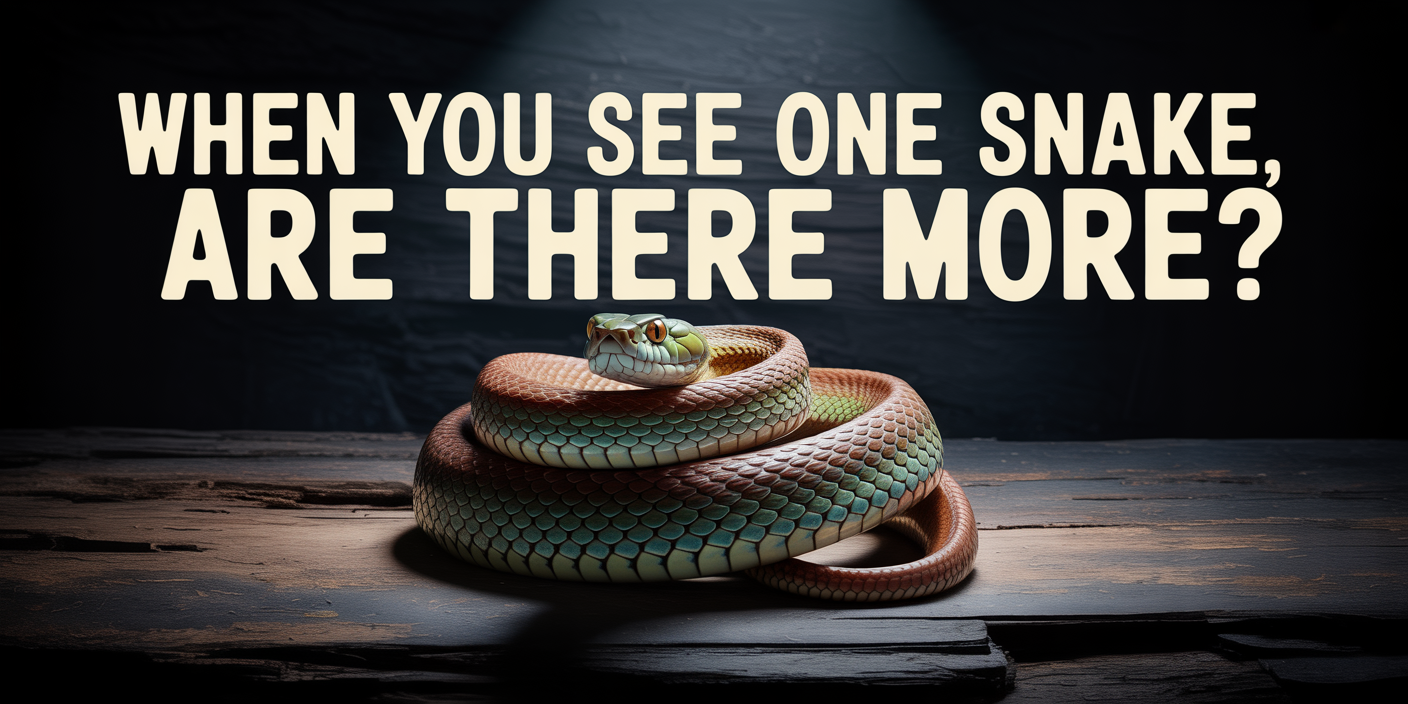“Yes—seeing one snake often means more could be nearby. In Florida’s Treasure Coast, snakes are drawn to the same food, water, and shelter sources, so where there’s one, there’s usually a reason for others to follow.”
Spotting a single snake on your property can be more than just a one-time scare—it might be a warning sign. Here in Florida’s Treasure Coast, where the warm climate and abundant wildlife create perfect conditions for reptiles, one snake could mean others are lurking nearby. Whether it’s slithering through your garden in Port St. Lucie or hiding under the shed in Vero Beach, that surprise sighting often raises the big question: Are there more?
The truth is, snakes don’t always travel alone. Certain species are solitary, but others may group together during mating season or when food and shelter are easy to find. And if your property happens to have rodent activity, excess moisture, or plenty of shaded hiding spots, it could be acting like a welcome mat for multiple snakes. Don’t shrug it off—your safety and peace of mind are worth a closer look.
What Does It Mean If You See One Snake?
Seeing one snake might not mean you’re dealing with an infestation, but it’s rarely a total coincidence—especially in the Treasure Coast. Most snakes are solitary creatures, but when you spot one, it’s often because something attracted it: food, water, or shelter. If those conditions are present, there’s a good chance others could be nearby or on their way.
In Florida, some snake species like garter snakes or corn snakes may gather in small numbers when mating or seeking warmth. If you’ve seen a snake around your home, it may have followed a scent trail from rodents, frogs, or even a chipmunk burrow. That’s why it’s smart to take one sighting seriously—it’s often nature’s red flag that your property is snake-friendly.
Why More Snakes Might Be Nearby
1. Mating Season Activity
During spring and early summer in Florida, snakes become more active as they search for mates. Some species, like garter snakes, are known to gather in small numbers during breeding season, which increases your chances of seeing more than one. If you spot a snake during this time of year, others may be hiding nearby or passing through.
2. Abundant Food Supply
Snakes follow their stomachs. If your property has a rodent issue—like rats, mice, or chipmunks—it becomes a hunting ground. Even frogs, lizards, and insects can attract different types of snakes. One sighting might mean others are already scoping out the area for the same reason.
3. Reliable Shelter
Overgrown landscaping, wood piles, rock beds, and cluttered sheds offer perfect hiding places for snakes. If your yard provides cool, quiet, undisturbed spaces, you’re essentially offering them a home. These areas can easily host more than one snake, especially if they remain untouched.
4. Moisture and Water Sources
Standing water, leaky faucets, birdbaths, or pet water bowls can attract not just prey—but snakes too. Moisture draws in frogs and bugs, and snakes naturally follow. In the humid Treasure Coast climate, shaded wet spots become ideal resting areas for reptiles looking to cool off.
5. Easy Access Points Into Your Home
If one snake found a way in, others can too. Gaps in your foundation, open vents, or unsealed pipes create easy entryways. Once inside, snakes may shelter in basements, crawl spaces, or even attics—especially during extreme heat or after heavy rainstorms.
Signs That Indicate a Snake Infestation
- Shed Snake Skins– Finding a dry, papery snake skin around your property is one of the clearest signs a snake has been there—and possibly still is. Snakes shed their skin as they grow, and these remnants are often left behind near hiding spots like crawl spaces, garages, or under decks.
- Snake Droppings or Musk Odor– Snake feces often contain hair or bone fragments from digested prey, making them different from most animal droppings. You might also notice a musky, unpleasant odor in enclosed areas, which some species release when threatened or marking territory.
- Tracks or Slither Marks– Look for narrow, wavy patterns in dusty areas, sand, or mulch. These trails are left behind as a snake moves across the surface and can help you identify recent activity, especially in garages or under porches.
- Sudden Disappearance of Rodents– If you used to see rats or chipmunks regularly but suddenly don’t, that might not be great news—it could mean a snake has moved in and disrupted the balance. While fewer rodents sounds good, the reason behind it could be slithering nearby.
- Hissing Sounds or Sightings in Repeated Areas- Hearing hissing behind walls or repeatedly seeing a snake in the same area (like a corner of your yard or garage) might mean it’s returned or has a den nearby. Multiple sightings in a short time span almost always indicate more than one snake or a recurring issue.
Where Snakes May Be Hiding on Your Property
Under Decks and Patios
If you suspect a snake in your backyard, start by checking under raised decks and patios. These shaded, undisturbed spots are ideal for snakes seeking shelter from heat. Loose boards, clutter, or stacked debris create prime hiding zones for pests—especially in Florida’s humid Treasure Coast. Homeowners often overlook these areas until they start noticing signs of a snake infestation like shed skins or strange noises.
In Sheds, Garages, and Crawl Spaces
Sheds and crawl spaces are hotspots for more than just yard tools—they’re often where you’ll find a hidden snake in your house or nearby structures. These spaces are quiet, dark, and frequently used as nesting sites. If you’ve spotted any movement or want to identify the snake you’ve seen slithering out from your garage, it’s a good idea to call a professional before things escalate into a full-blown pest issue.
Near Pool Equipment and A/C Units
Pool pump stations, AC units, and backyard utility corners are more than just mechanical hubs—they’re popular snake shelters. These warm and often shaded areas create a safe retreat for snakes during temperature swings. Since they’re rarely disturbed, they can easily host a snake unnoticed for weeks, adding risk to your everyday outdoor activities.
Along Fences, Rock Borders, and Retaining Walls
Landscaping details like rock walls and fence lines might make your yard look tidy, but they’re also perfect cover for a snake on the move. Gaps in stone borders and shrubs provide concealment while still offering a view of prey like frogs or rodents. If you’re spotting odd tracks or tail trails along these features, it might be time to check for other signs of a snake infestation.
Near Water Sources and Drainage Areas
Water sources in your backyard can do more than hydrate your plants—they can attract snakes. Leaky hoses, birdbaths, and garden ponds pull in frogs and insects, which in turn draw in reptiles. If you’re seeing consistent wildlife traffic near these wet zones, there’s a chance you’re unknowingly creating a pest buffet that’s too good for snakes to ignore.
What to Do If You See a Snake
- Stay Calm and Keep Your Distance– It’s easy to panic when you see a snake, but most won’t attack unless threatened. Step back slowly and keep pets, kids, and anyone else away from the area. Never try to touch, trap, or corner the snake yourself—even non-venomous species can bite if provoked.
- Don’t Try to Remove It Yourself– Attempting DIY removal can be dangerous and may violate Florida wildlife regulations. Misidentifying a species could result in serious injury or improper handling. That’s why it’s best to leave it to licensed experts who know how to assess the situation safely.
- Secure the Area and Monitor From Afar– If you can do so safely, keep an eye on the snake’s location from a distance. This helps the wildlife technician know where to start when they arrive. Close off access to nearby areas like sheds or crawl spaces to prevent the snake from disappearing deeper into your property.
- Call a Local Expert Immediately– Contact AAAC Wildlife Removal of Treasure Coast right away. Our team is trained in snake identification, safe removal, and preventive exclusion. We’ll not only remove the snake but also inspect your property for signs of more and seal off potential entry points.
How AAAC Wildlife Removal of Treasure Coast Can Help
At AAAC Wildlife Removal of Treasure Coast, we don’t just remove the snake you see—we figure out why it’s there and how to stop more from coming. Our trained technicians start with a full inspection of your property, checking common Florida hiding spots like pool equipment areas, under decks, sheds, and crawl spaces. We’re experts at identifying both venomous and non-venomous species and use safe, humane methods to remove them without putting you or your family at risk.
Beyond the removal, we focus on long-term prevention. That means sealing off entry points, identifying and removing food sources like rodents, and making habitat adjustments that discourage snakes from returning. Since we’re local to the Treasure Coast, we understand the unique challenges of this area—from the humid climate to the neighborhood layouts in places like Port St. Lucie and Vero Beach. Our team is licensed, insured, and fast to respond—so you’re not left wondering what else might be hiding nearby.




